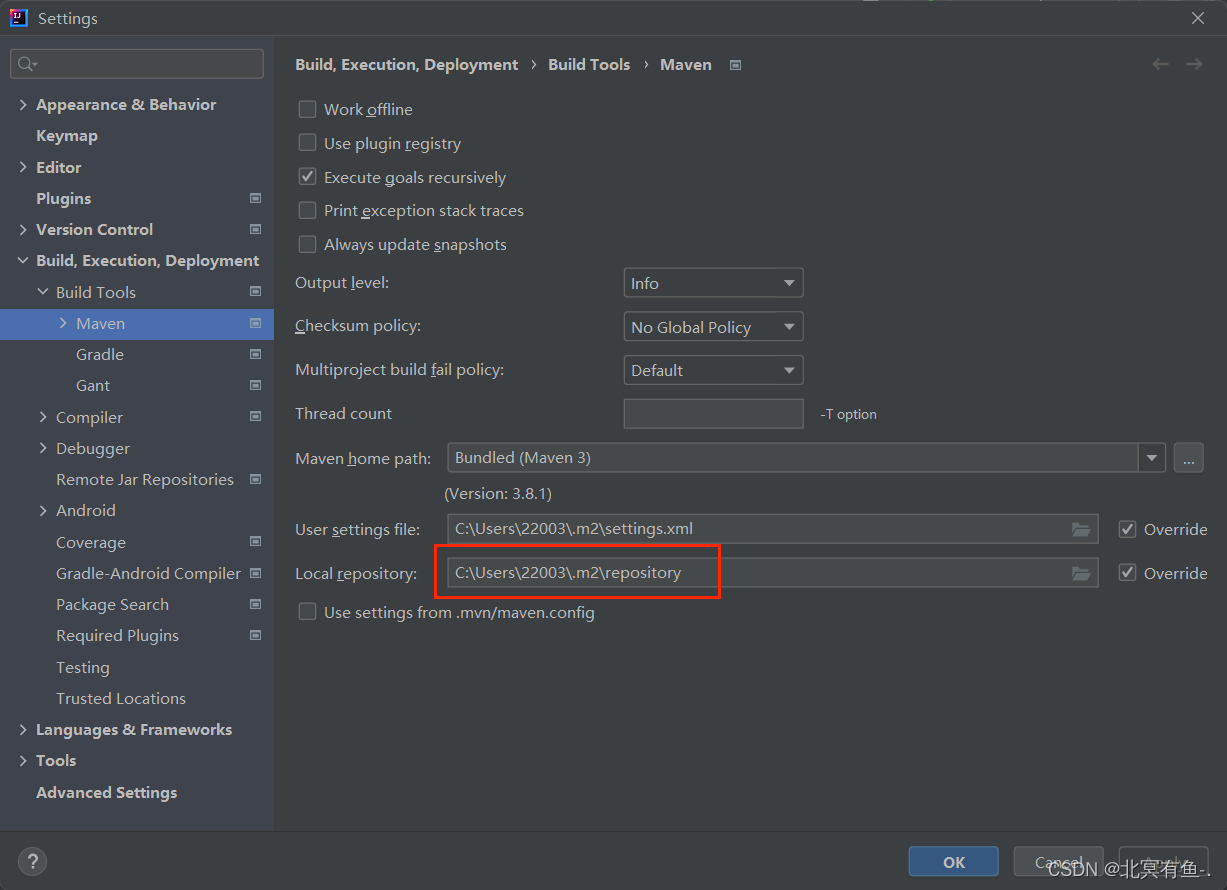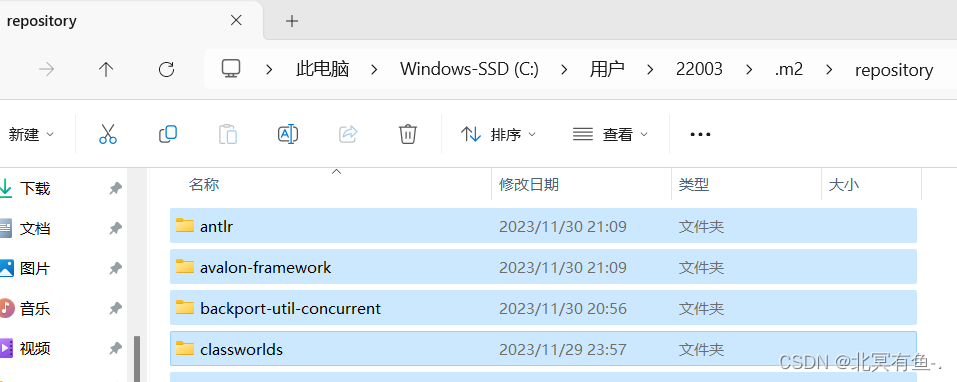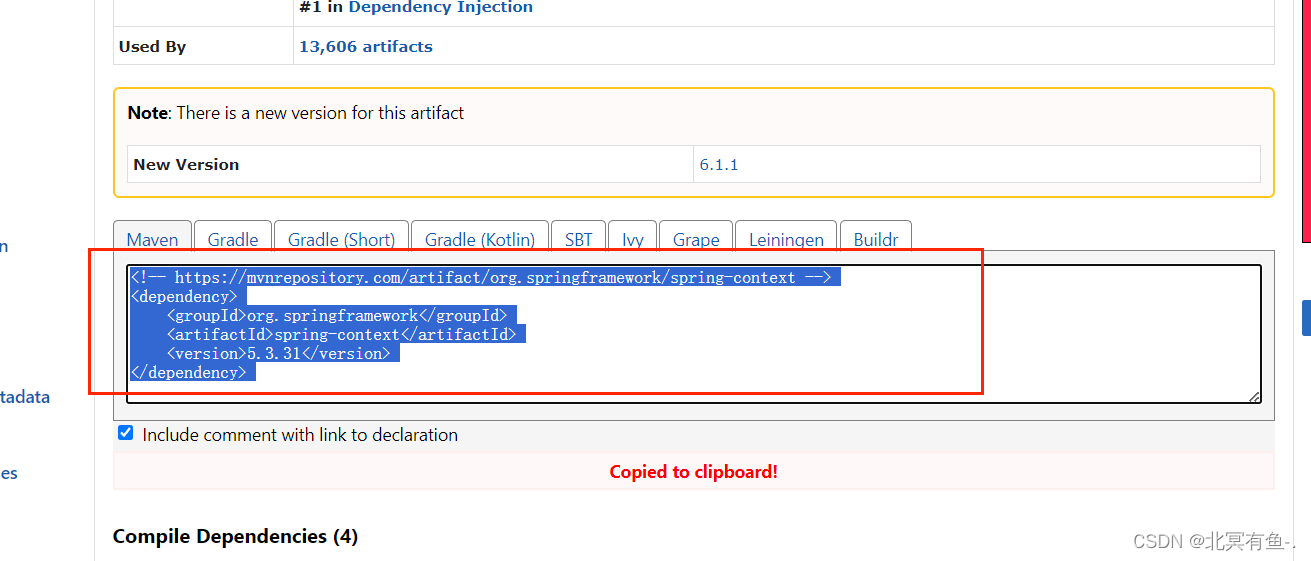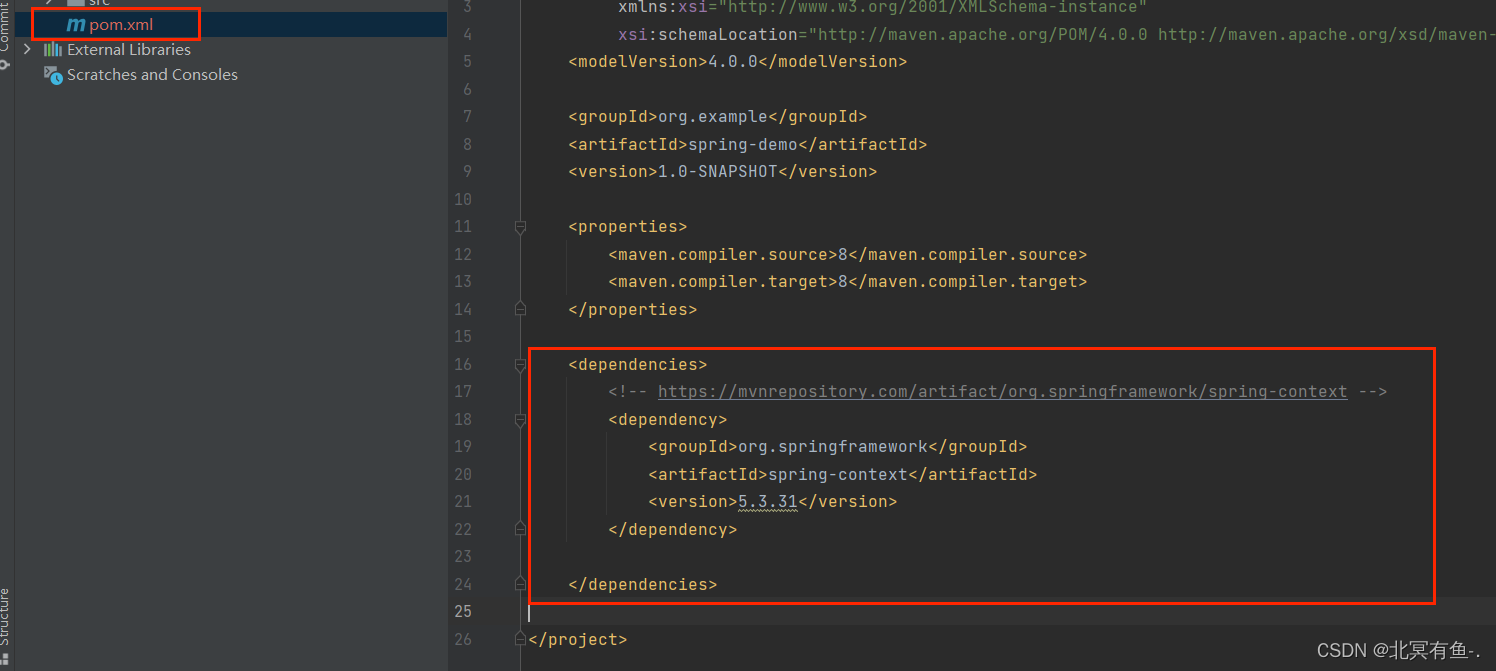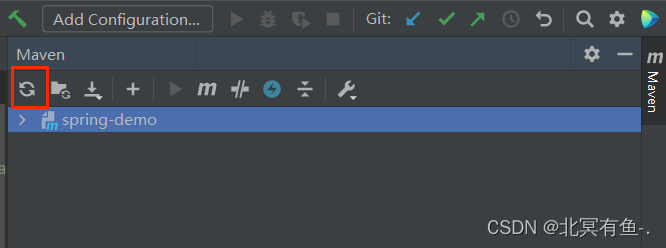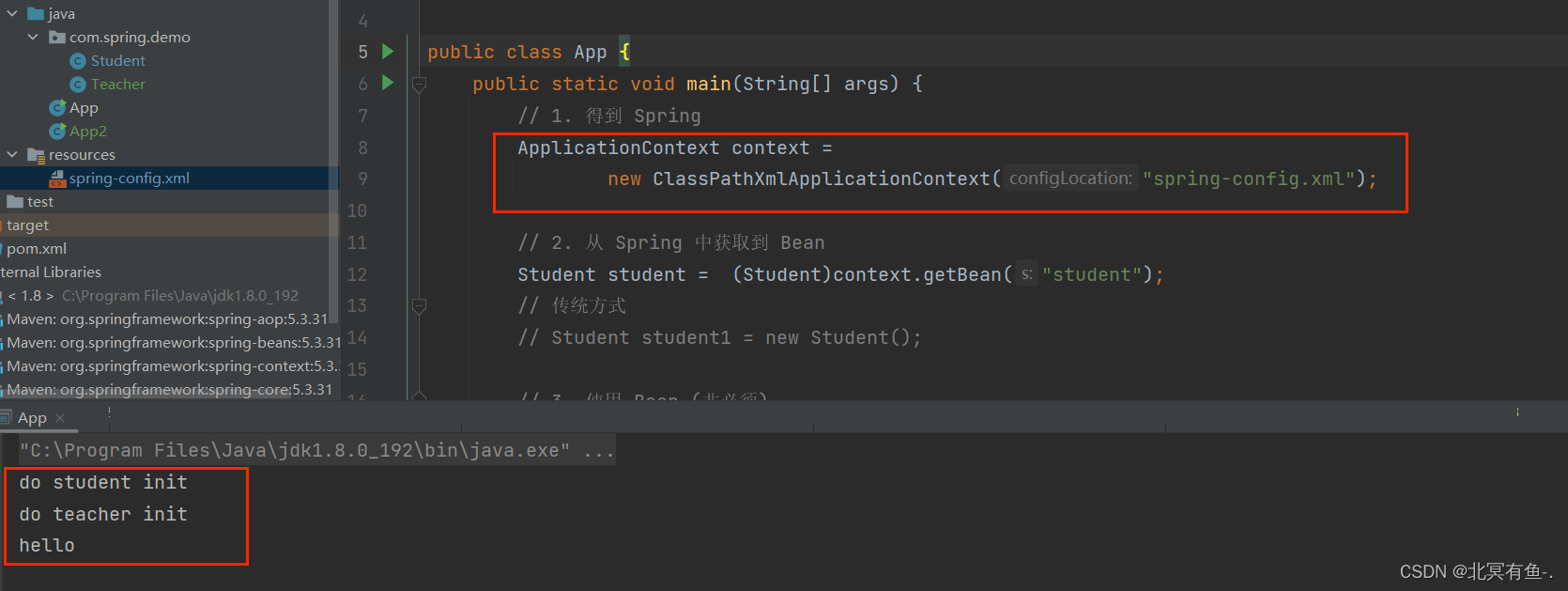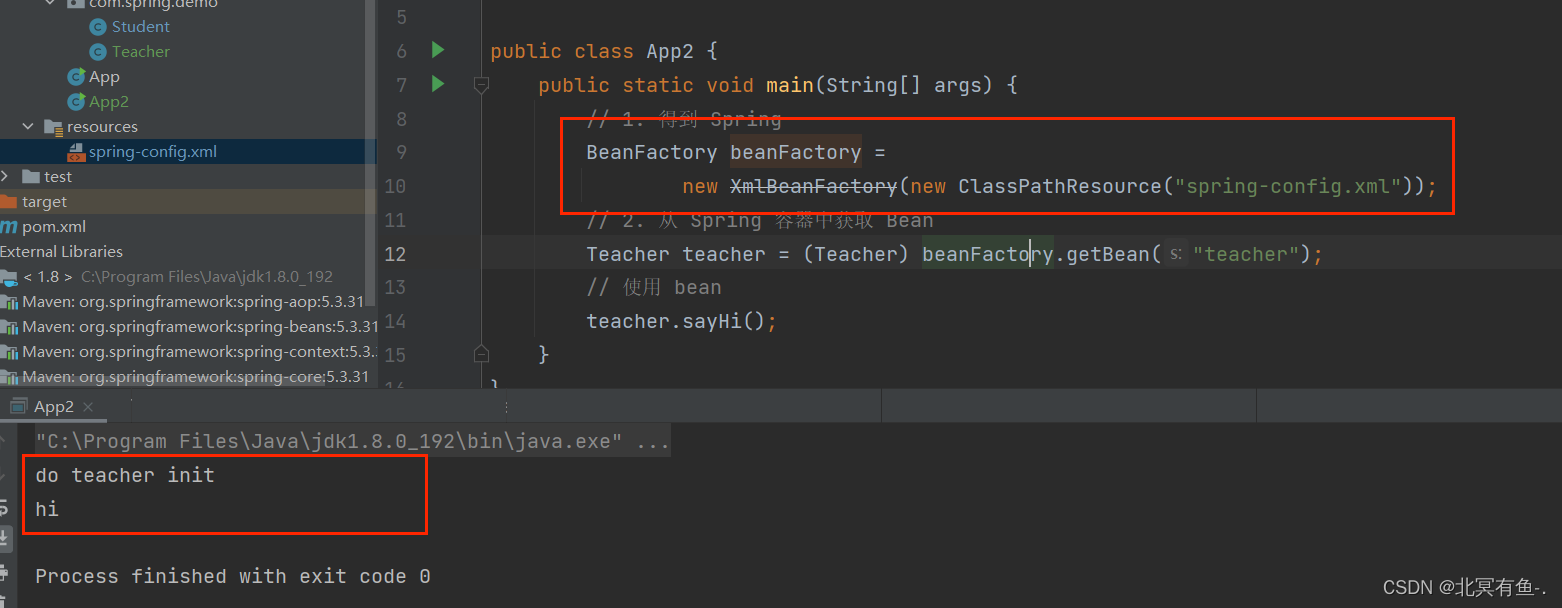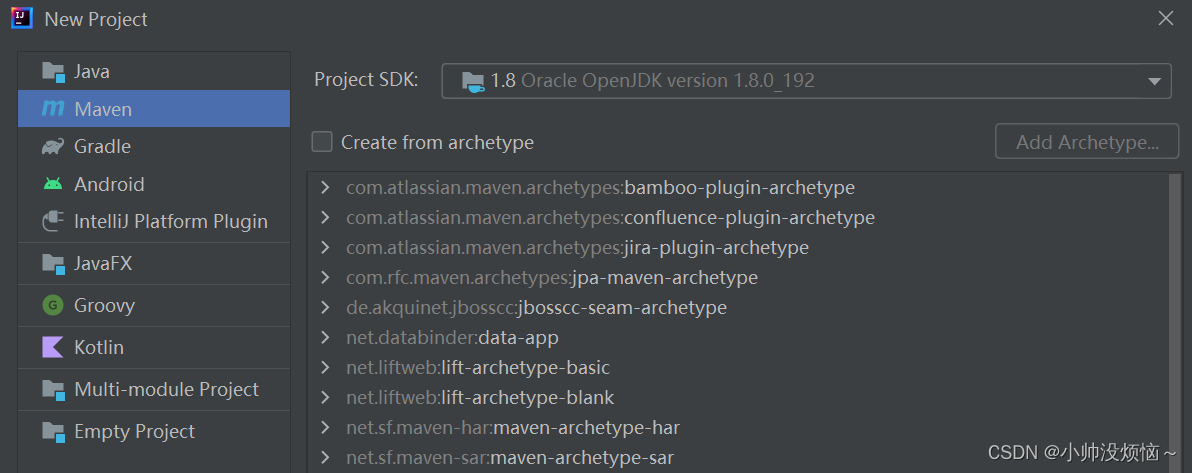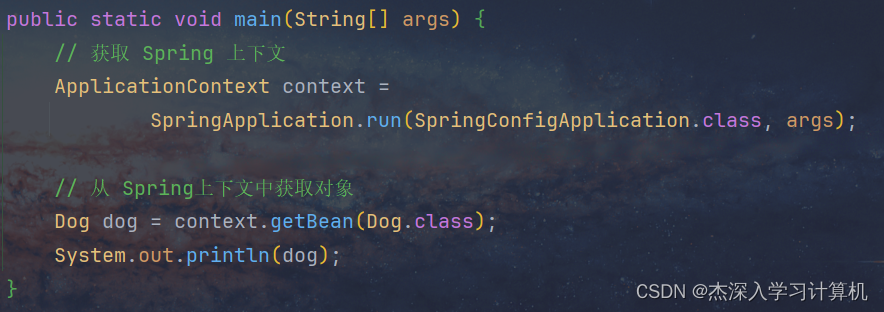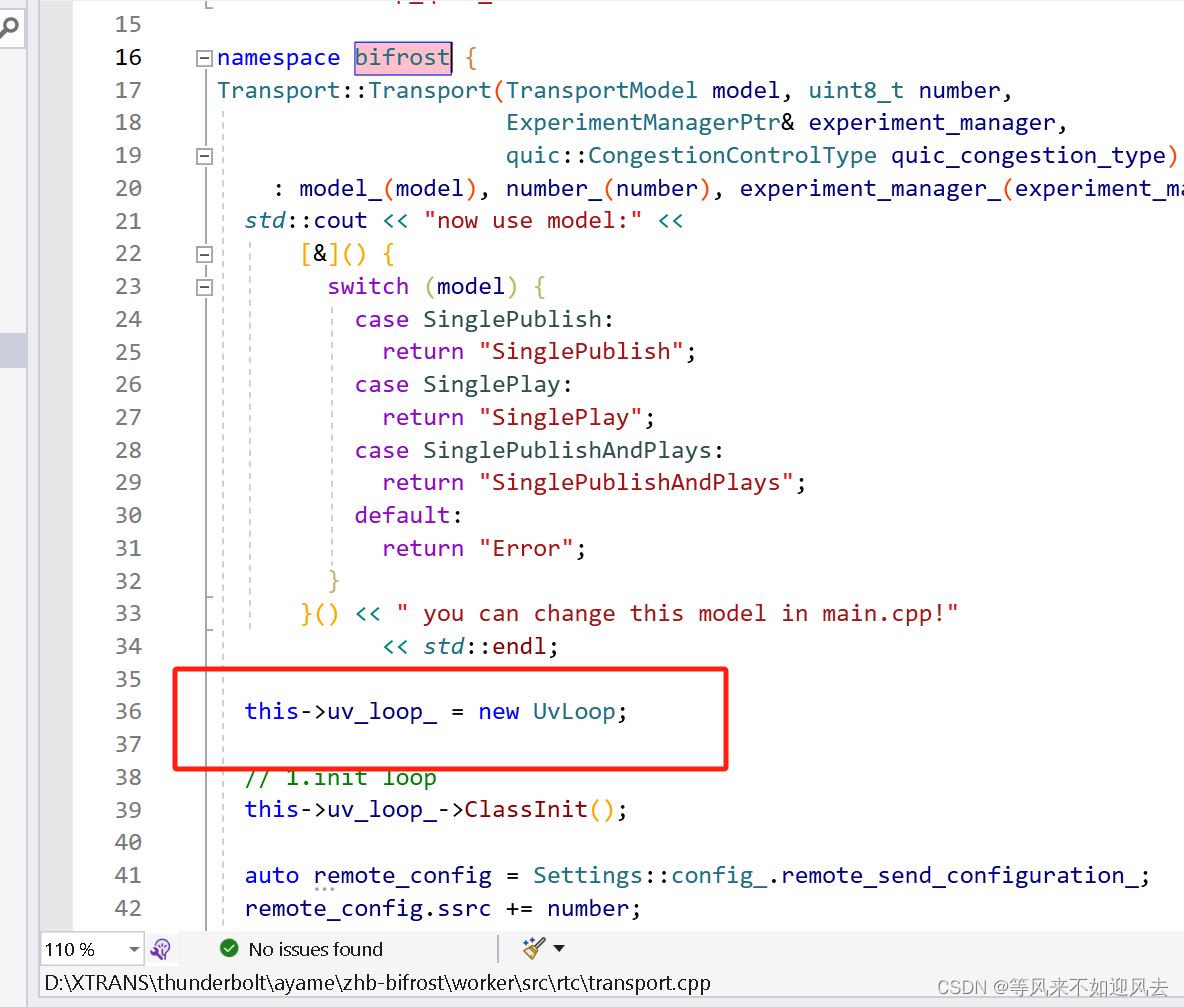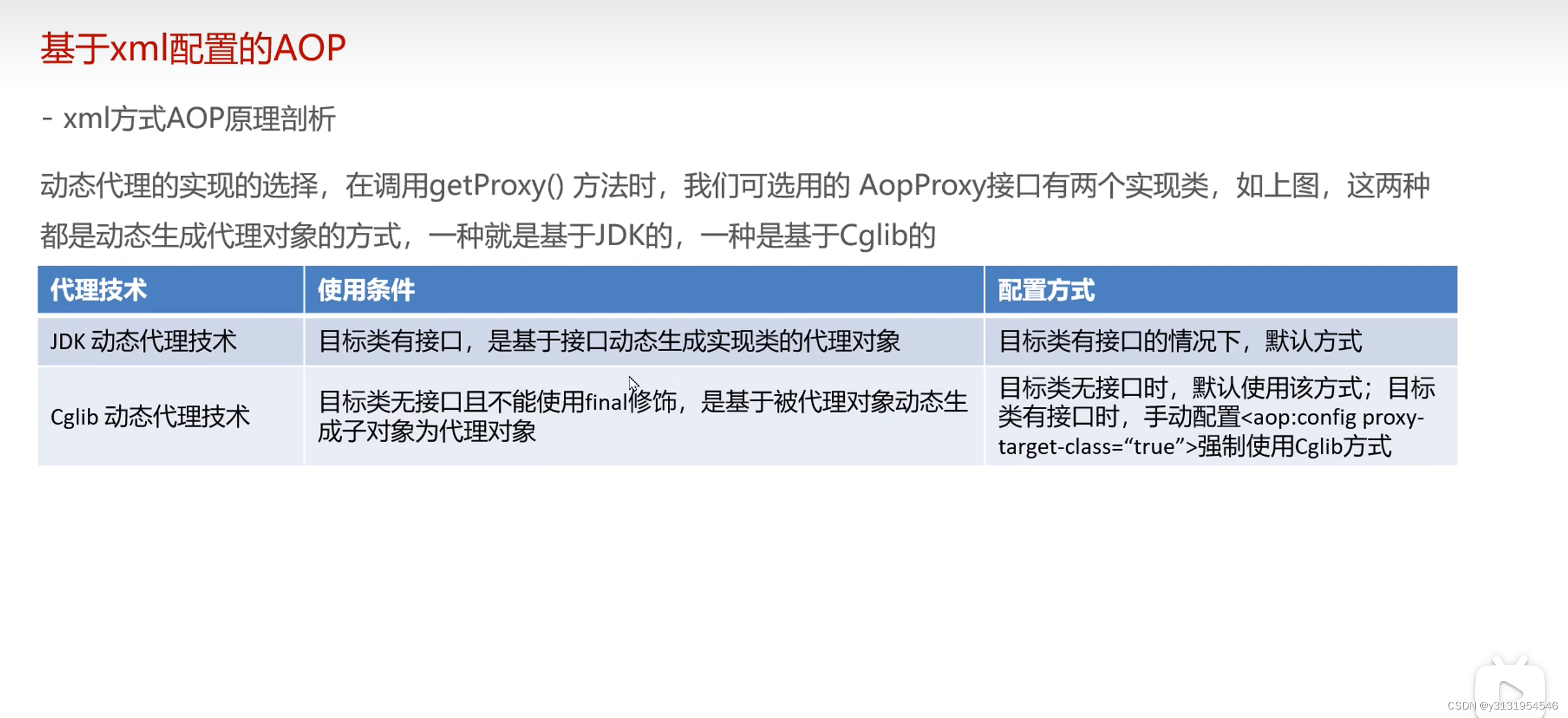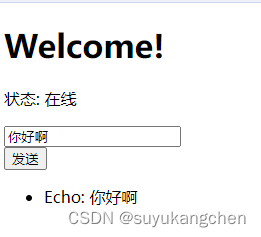文章目录
String 的创建和使用
上一篇博客, 我们了解到, Spring 就是一个包含了众多工具和方法的 IoC 容器. 所以他就有两个最基本的功能:
1. 创建 Spring 对象
打开 IDEA 使用 Maven 方式来创建一个 Spring 项目
1.1 创建一个 Maven 项目
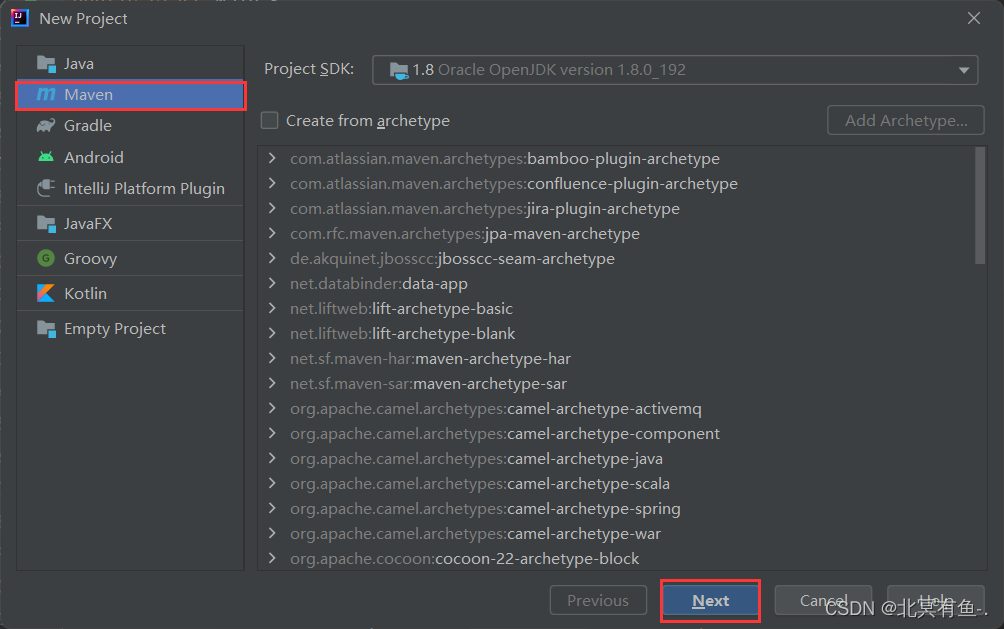
此处一定注意路径中不能有中文, 空格
项目名一般都用小写字母, 用 – 隔开
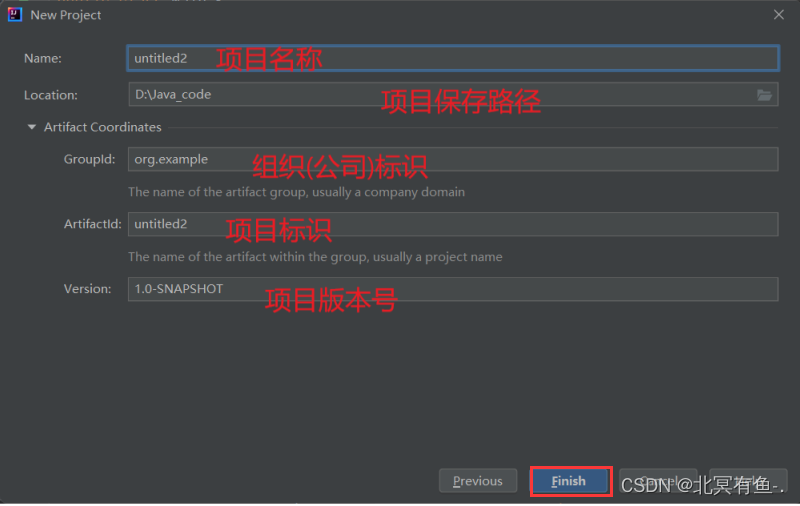
这样就创建好了一个 Maven 项目
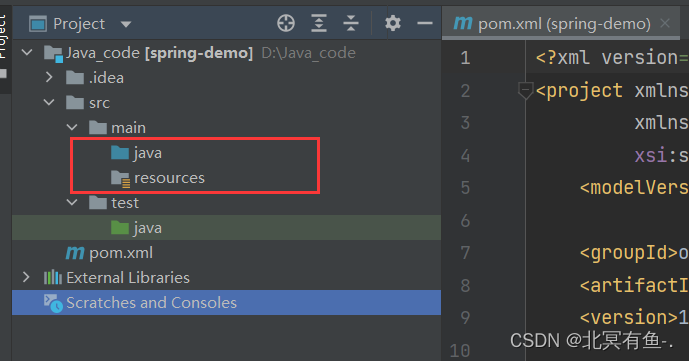
1.2 添加 Spring 依赖(极其重要)
1). 检测 Maven 的配置是否正确,
idea 的设置文件有两个, 一个是当前项目的配置文件, 另一个是新项目的配置文件. 我们需要把这两个都配置好
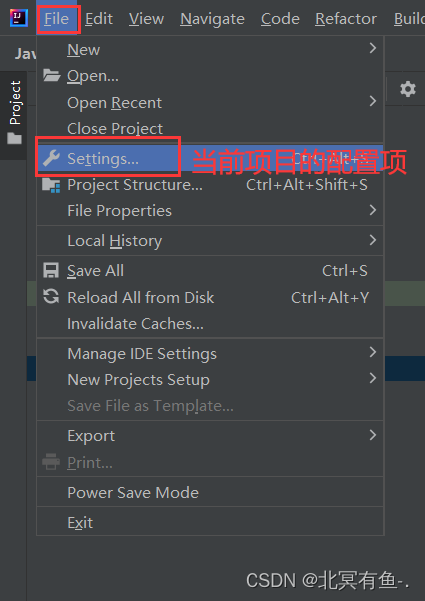
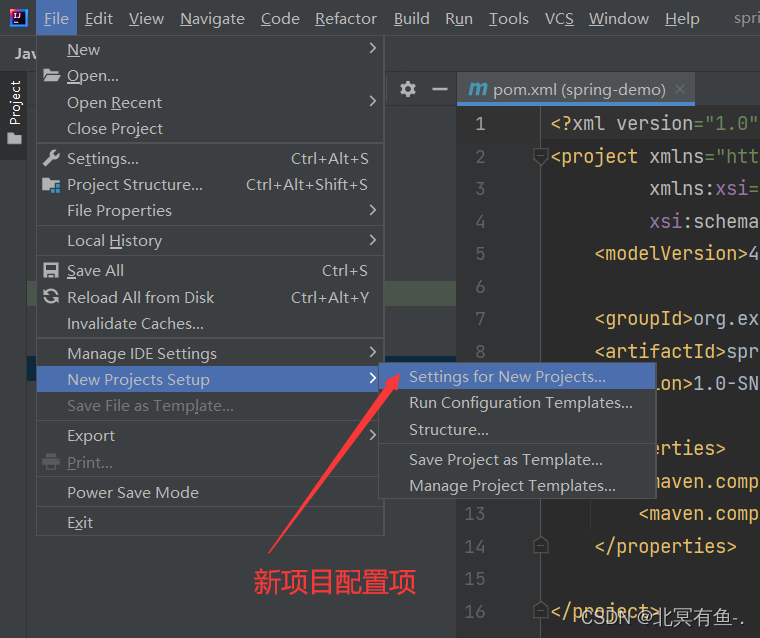
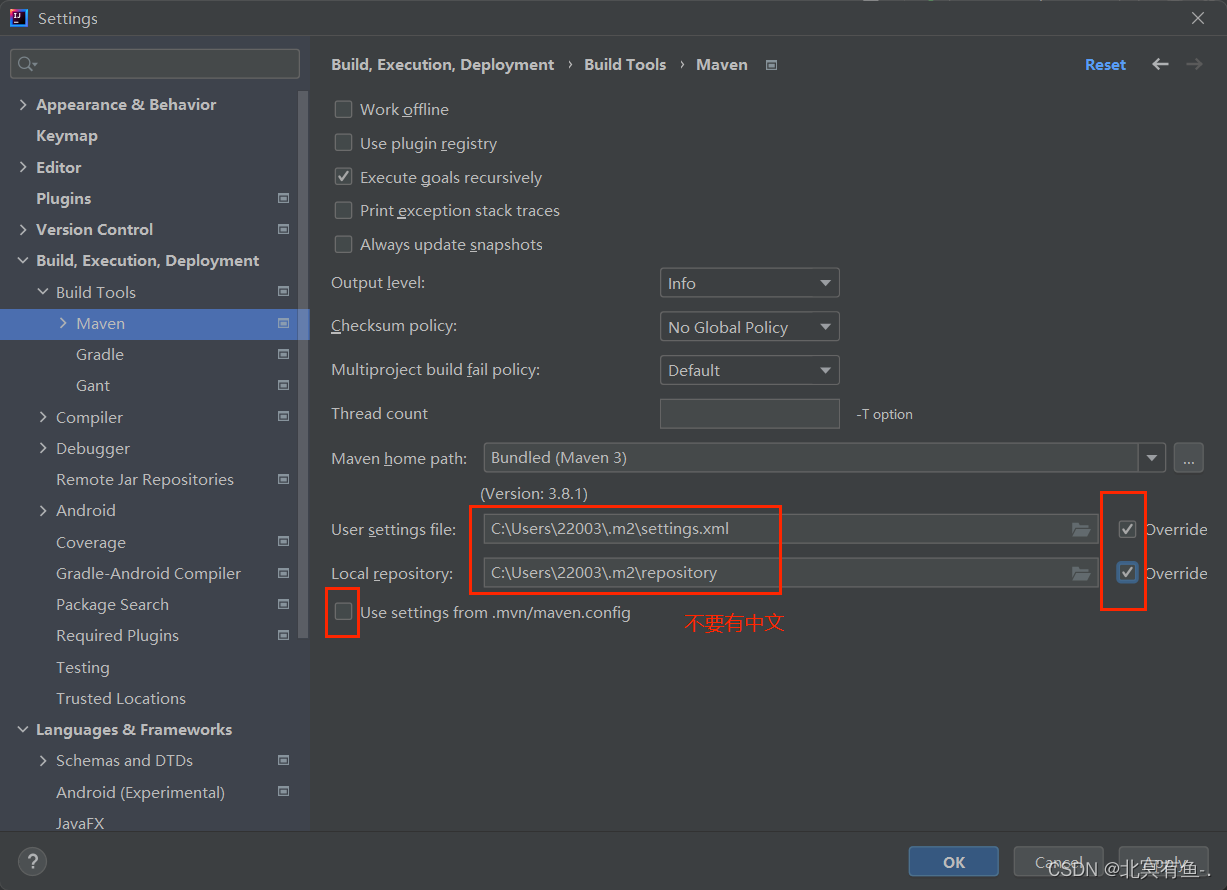
如果目录下没有 settings.xml 文件, 使用下面的文件
<?xml version="1.0" encoding="UTF-8"?>
<!--
Licensed to the Apache Software Foundation (ASF) under one
or more contributor license agreements. See the NOTICE file
distributed with this work for additional information
regarding copyright ownership. The ASF licenses this file
to you under the Apache License, Version 2.0 (the
"License"); you may not use this file except in compliance
with the License. You may obtain a copy of the License at
http://www.apache.org/licenses/LICENSE-2.0
Unless required by applicable law or agreed to in writing,
software distributed under the License is distributed on an
"AS IS" BASIS, WITHOUT WARRANTIES OR CONDITIONS OF ANY
KIND, either express or implied. See the License for the
specific language governing permissions and limitations
under the License.
-->
<!--
| This is the configuration file for Maven. It can be specified at two levels:
|
| 1. User Level. This settings.xml file provides configuration for a single user,
| and is normally provided in ${user.home}/.m2/settings.xml.
|
| NOTE: This location can be overridden with the CLI option:
|
| -s /path/to/user/settings.xml
|
| 2. Global Level. This settings.xml file provides configuration for all Maven
| users on a machine (assuming they're all using the same Maven
| installation). It's normally provided in
| ${maven.conf}/settings.xml.
|
| NOTE: This location can be overridden with the CLI option:
|
| -gs /path/to/global/settings.xml
|
| The sections in this sample file are intended to give you a running start at
| getting the most out of your Maven installation. Where appropriate, the default
| values (values used when the setting is not specified) are provided.
|
|-->
<settings xmlns="http://maven.apache.org/SETTINGS/1.0.0"
xmlns:xsi="http://www.w3.org/2001/XMLSchema-instance"
xsi:schemaLocation="http://maven.apache.org/SETTINGS/1.0.0 http://maven.apache.org/xsd/settings-1.0.0.xsd">
<!-- localRepository
| The path to the local repository maven will use to store artifacts.
|
| Default: ${user.home}/.m2/repository
<localRepository>/path/to/local/repo</localRepository>
-->
<!-- interactiveMode
| This will determine whether maven prompts you when it needs input. If set to false,
| maven will use a sensible default value, perhaps based on some other setting, for
| the parameter in question.
|
| Default: true
<interactiveMode>true</interactiveMode>
-->
<!-- offline
| Determines whether maven should attempt to connect to the network when executing a build.
| This will have an effect on artifact downloads, artifact deployment, and others.
|
| Default: false
<offline>false</offline>
-->
<!-- pluginGroups
| This is a list of additional group identifiers that will be searched when resolving plugins by their prefix, i.e.
| when invoking a command line like "mvn prefix:goal". Maven will automatically add the group identifiers
| "org.apache.maven.plugins" and "org.codehaus.mojo" if these are not already contained in the list.
|-->
<pluginGroups>
<!-- pluginGroup
| Specifies a further group identifier to use for plugin lookup.
<pluginGroup>com.your.plugins</pluginGroup>
-->
</pluginGroups>
<!-- proxies
| This is a list of proxies which can be used on this machine to connect to the network.
| Unless otherwise specified (by system property or command-line switch), the first proxy
| specification in this list marked as active will be used.
|-->
<proxies>
<!-- proxy
| Specification for one proxy, to be used in connecting to the network.
|
<proxy>
<id>optional</id>
<active>true</active>
<protocol>http</protocol>
<username>proxyuser</username>
<password>proxypass</password>
<host>proxy.host.net</host>
<port>80</port>
<nonProxyHosts>local.net|some.host.com</nonProxyHosts>
</proxy>
-->
</proxies>
<!-- servers
| This is a list of authentication profiles, keyed by the server-id used within the system.
| Authentication profiles can be used whenever maven must make a connection to a remote server.
|-->
<servers>
<!-- server
| Specifies the authentication information to use when connecting to a particular server, identified by
| a unique name within the system (referred to by the 'id' attribute below).
|
| NOTE: You should either specify username/password OR privateKey/passphrase, since these pairings are
| used together.
|
<server>
<id>deploymentRepo</id>
<username>repouser</username>
<password>repopwd</password>
</server>
-->
<!-- Another sample, using keys to authenticate.
<server>
<id>siteServer</id>
<privateKey>/path/to/private/key</privateKey>
<passphrase>optional; leave empty if not used.</passphrase>
</server>
-->
</servers>
<!-- mirrors
| This is a list of mirrors to be used in downloading artifacts from remote repositories.
|
| It works like this: a POM may declare a repository to use in resolving certain artifacts.
| However, this repository may have problems with heavy traffic at times, so people have mirrored
| it to several places.
|
| That repository definition will have a unique id, so we can create a mirror reference for that
| repository, to be used as an alternate download site. The mirror site will be the preferred
| server for that repository.
|-->
<mirrors>
<mirror>
<id>alimaven</id>
<name>aliyun maven</name>
<url>http://maven.aliyun.com/nexus/content/groups/public/</url>
<mirrorOf>central</mirrorOf>
</mirror>
<!-- mirror
| Specifies a repository mirror site to use instead of a given repository. The repository that
| this mirror serves has an ID that matches the mirrorOf element of this mirror. IDs are used
| for inheritance and direct lookup purposes, and must be unique across the set of mirrors.
|
<mirror>
<id>mirrorId</id>
<mirrorOf>repositoryId</mirrorOf>
<name>Human Readable Name for this Mirror.</name>
<url>http://my.repository.com/repo/path</url>
</mirror>
-->
</mirrors>
<!-- profiles
| This is a list of profiles which can be activated in a variety of ways, and which can modify
| the build process. Profiles provided in the settings.xml are intended to provide local machine-
| specific paths and repository locations which allow the build to work in the local environment.
|
| For example, if you have an integration testing plugin - like cactus - that needs to know where
| your Tomcat instance is installed, you can provide a variable here such that the variable is
| dereferenced during the build process to configure the cactus plugin.
|
| As noted above, profiles can be activated in a variety of ways. One way - the activeProfiles
| section of this document (settings.xml) - will be discussed later. Another way essentially
| relies on the detection of a system property, either matching a particular value for the property,
| or merely testing its existence. Profiles can also be activated by JDK version prefix, where a
| value of '1.4' might activate a profile when the build is executed on a JDK version of '1.4.2_07'.
| Finally, the list of active profiles can be specified directly from the command line.
|
| NOTE: For profiles defined in the settings.xml, you are restricted to specifying only artifact
| repositories, plugin repositories, and free-form properties to be used as configuration
| variables for plugins in the POM.
|
|-->
<profiles>
<!-- profile
| Specifies a set of introductions to the build process, to be activated using one or more of the
| mechanisms described above. For inheritance purposes, and to activate profiles via <activatedProfiles/>
| or the command line, profiles have to have an ID that is unique.
|
| An encouraged best practice for profile identification is to use a consistent naming convention
| for profiles, such as 'env-dev', 'env-test', 'env-production', 'user-jdcasey', 'user-brett', etc.
| This will make it more intuitive to understand what the set of introduced profiles is attempting
| to accomplish, particularly when you only have a list of profile id's for debug.
|
| This profile example uses the JDK version to trigger activation, and provides a JDK-specific repo.
<profile>
<id>jdk-1.4</id>
<activation>
<jdk>1.4</jdk>
</activation>
<repositories>
<repository>
<id>jdk14</id>
<name>Repository for JDK 1.4 builds</name>
<url>http://www.myhost.com/maven/jdk14</url>
<layout>default</layout>
<snapshotPolicy>always</snapshotPolicy>
</repository>
</repositories>
</profile>
-->
<!--
| Here is another profile, activated by the system property 'target-env' with a value of 'dev',
| which provides a specific path to the Tomcat instance. To use this, your plugin configuration
| might hypothetically look like:
|
| ...
| <plugin>
| <groupId>org.myco.myplugins</groupId>
| <artifactId>myplugin</artifactId>
|
| <configuration>
| <tomcatLocation>${tomcatPath}</tomcatLocation>
| </configuration>
| </plugin>
| ...
|
| NOTE: If you just wanted to inject this configuration whenever someone set 'target-env' to
| anything, you could just leave off the <value/> inside the activation-property.
|
<profile>
<id>env-dev</id>
<activation>
<property>
<name>target-env</name>
<value>dev</value>
</property>
</activation>
<properties>
<tomcatPath>/path/to/tomcat/instance</tomcatPath>
</properties>
</profile>
-->
</profiles>
<!-- activeProfiles
| List of profiles that are active for all builds.
|
<activeProfiles>
<activeProfile>alwaysActiveProfile</activeProfile>
<activeProfile>anotherAlwaysActiveProfile</activeProfile>
</activeProfiles>
-->
</settings>
2). 然后重新下载 jar 包

首先打开 Maven 仓库, 搜索 spring, 选择 Spring Context

我们进来看到有很多版本, 我们这里使用 5.x 的, 因为我们使用的是 JDK8

复制到 pom.xml.
首先创建一个 标签, 然后粘贴到里面
3). 创建启动类

这样我们就创建好了一个 Spring 项目
2. 将 Bean 对象储存到 Spring 容器中
2.1 创建一个 Bean
在 Java 中一个对象如果被使用多次, 就可以称之为 Bean
public class Student {
public void sayHello() {
System.out.println("hello");
}
}
2.2 将 Bean 存到 Spring 容器中
创建一个 File, 配置文件

<?xml version="1.0" encoding="UTF-8"?>
<beans xmlns="http://www.springframework.org/schema/beans"
xmlns:xsi="http://www.w3.org/2001/XMLSchema-instance"
xsi:schemaLocation="http://www.springframework.org/schema/beans http://www.springframework.org/schema/beans/spring-beans.xsd http://www.springframework.org/schema/context https://www.springframework.org/schema/context/spring-context.xsd">
</beans>
<?xml version="1.0" encoding="UTF-8"?>
<beans xmlns="http://www.springframework.org/schema/beans"
xmlns:xsi="http://www.w3.org/2001/XMLSchema-instance"
xsi:schemaLocation="http://www.springframework.org/schema/beans http://www.springframework.org/schema/beans/spring-beans.xsd http://www.springframework.org/schema/context https://www.springframework.org/schema/context/spring-context.xsd">
<!-- 将 bean (Student) 存在 Spring 容器中, 它的名称叫做 student-->
<bean id="student" class="Student"> </bean>
</beans>

注意这里的 class 如果在包里, 得写包名.类名. 比如

2.3 从 Spring 容器中读取到 Bean
得到 Spring (上下文) 对象
Spring 上下⽂对象可使⽤ ApplicationContext
// 1.得到 Spring 的上下⽂对象,创建的时候需要配置 Spring 配置信息
ApplicationContext context = new ClassPathXmlApplicationContext("spring-config.xml");
除了 ApplicationContext 之外,我们还可以使⽤ BeanFactory 来作为 Spring 的上下⽂,如下代码所示:
BeanFactory beanFactory = new XmlBeanFactory(new ClassPathResource("spring-config.xml"));
1. 得到 Spring

2. 从 Spring 中获取到 Bean 对象


这两处的名称必须得对应
3. 使用 Bean

import com.spring.demo.Student;
import org.springframework.context.ApplicationContext;
import org.springframework.context.support.ClassPathXmlApplicationContext;
public class App {
public static void main(String[] args) {
// 1. 得到 Spring
ApplicationContext context =
new ClassPathXmlApplicationContext("spring-config.xml");
// 2. 从 Spring 中获取到 Bean
Student student = (Student)context.getBean("student");
// 传统方式
// Student student1 = new Student();
// 3. 使用 Bean (非必须)
student.sayHello();
}
}
4. 验证
3. ApplicationContext VS BeanFactory
package com.spring.demo;
public class Student {
public Student() {
System.out.println("do student init");
}
public void sayHello() {
System.out.println("hello");
}
}
package com.spring.demo;
public class Teacher {
public Teacher() {
System.out.println("do teacher init");
}
public void sayHi() {
System.out.println("hi");
}
}
import com.spring.demo.Teacher;
import org.springframework.beans.factory.BeanFactory;
import org.springframework.beans.factory.xml.XmlBeanFactory;
import org.springframework.core.io.ClassPathResource;
public class App2 {
public static void main(String[] args) {
// 1. 得到 Spring
BeanFactory beanFactory =
new XmlBeanFactory(new ClassPathResource("spring-config.xml"));
// 2. 从 Spring 容器中获取 Bean
Teacher teacher = (Teacher) beanFactory.getBean("teacher");
// 使用 bean
teacher.sayHi();
}
}
import com.spring.demo.Student;
import org.springframework.context.ApplicationContext;
import org.springframework.context.support.ClassPathXmlApplicationContext;
public class App {
public static void main(String[] args) {
// 1. 得到 Spring
ApplicationContext context =
new ClassPathXmlApplicationContext("spring-config.xml");
// 2. 从 Spring 中获取到 Bean
Student student = (Student)context.getBean("student");
// 传统方式
// Student student1 = new Student();
// 3. 使用 Bean (非必须)
student.sayHello();
}
}
我们再进行调整, 只进行得到 Spring
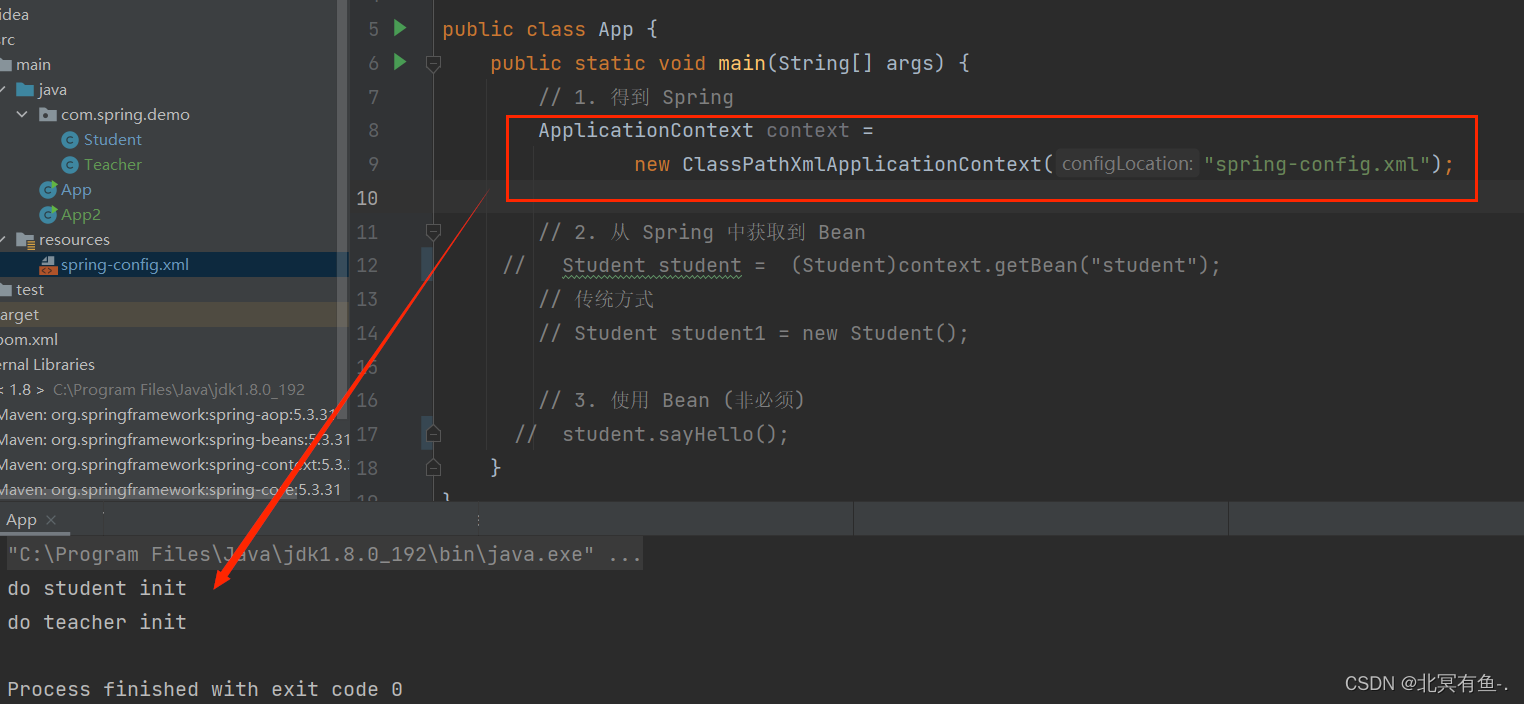

观察类关系
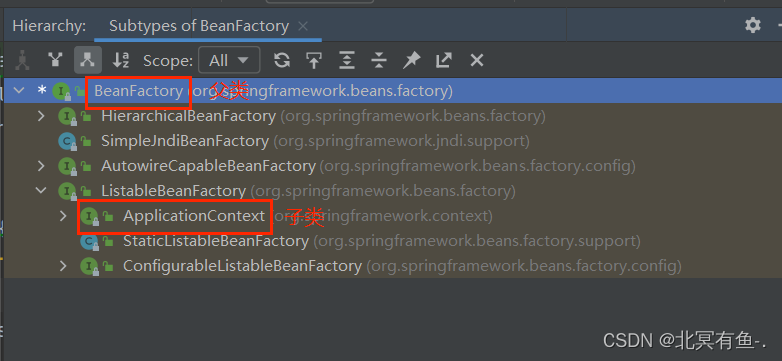
-
使用 ApplicationContext 打印结果 , 会将 xml 中所有的对象存储到 spring 容器中(进行实例化)
-
使用 BeanFactory 打印结果, 可见它是属于 惰性加载(lazy load), 只有调用 getBean 才会去加载对应的Bean
特征:
- 使用 ApplicationContext 比较费内存, 一次性加载, 之后读取就会非常快
- 使用 BeanFactory 节省内存, 调用的时候才会加载初始化 bean 到 spring 中, 所以效率不高.
- 继承关系和功能⽅⾯来说:Spring 容器有两个顶级的接⼝:BeanFactory 和 ApplicationContext。其中 BeanFactory 提供了基础的访问容器的能⼒,⽽ ApplicationContext 属于 BeanFactory 的⼦类,它除了继承了 BeanFactory 的所有功能之外,它还拥有独特的特性,还添加了对国际化⽀持、资源访问⽀持、以及事件传播等⽅⾯的⽀持。
- 从性能⽅⾯来说:ApplicationContext 是⼀次性加载并初始化所有的 Bean 对象,⽽
BeanFactory 是需要哪个才去哪载那个,因此更加轻量。
4. 获取 Bean 的三种方式
- 通过名称获取
Student student = (Student)context.getBean("student");
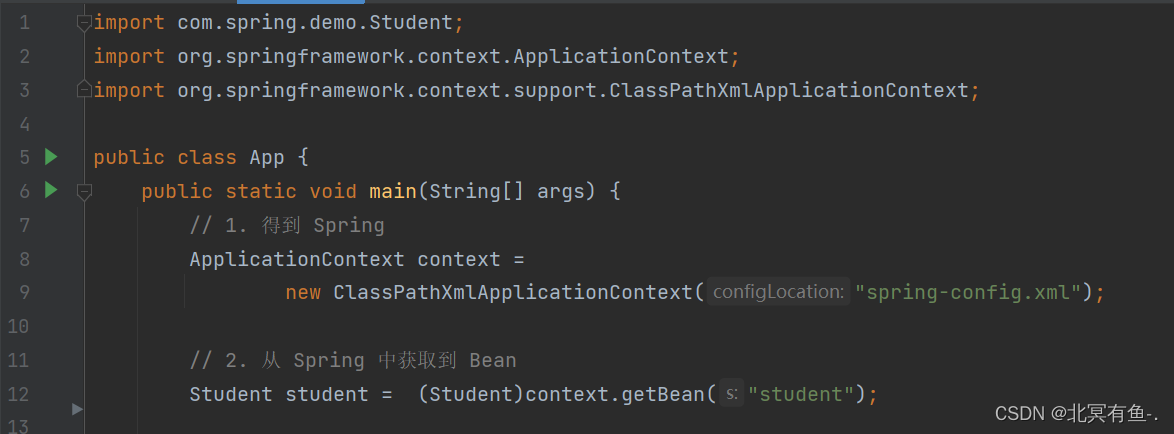
Student student = context.getBean(Student.class);
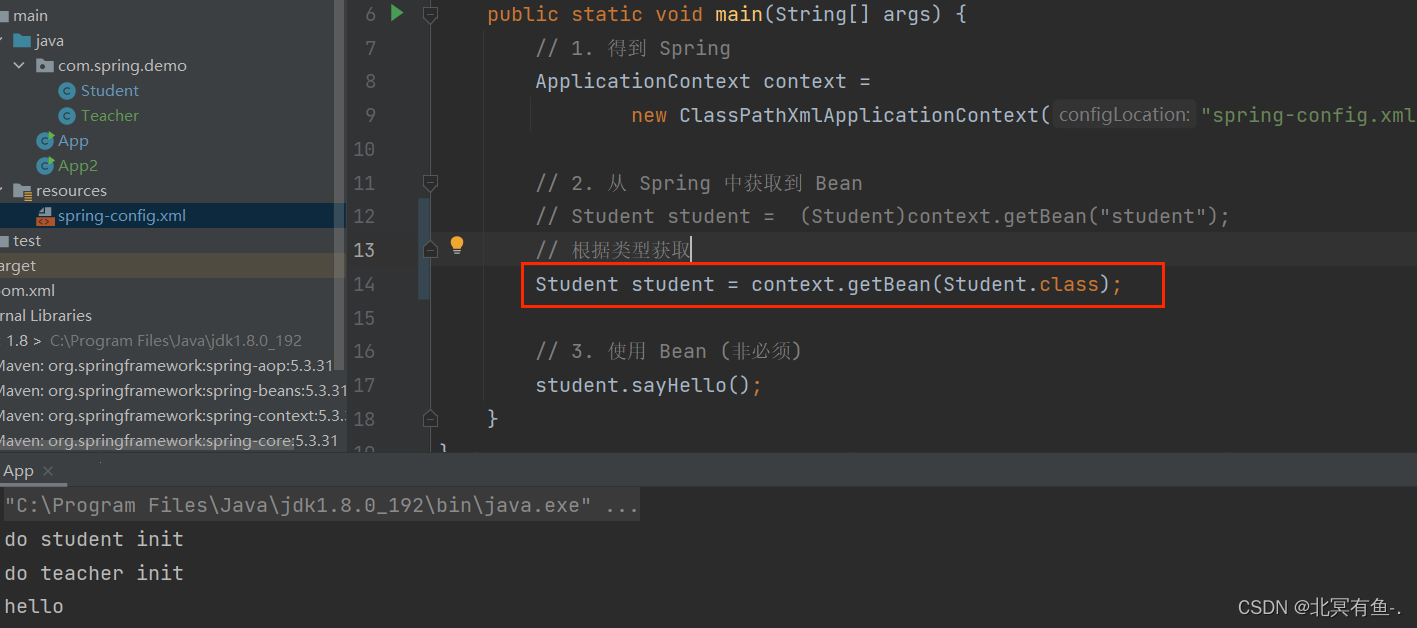
这种方式看着简洁, 但是如果 spring 中 存储了多个同种类型的变量, 就会出问题
Student student = context.getBean("stu", Student.class);

总结:
- 创建 Spring 项目
a. 创建一个 maven 项目
b. 添加 Spring-context 依赖
c. 创建一个启动类(为后面从 spring 容器中获取 bean 对象) - 存储 Bean
a. 先创建 Bean 对象
b. 通过 Spring 配置文件 (spring-config.xml)
<bean id="bean名称" class="包名.类名"> < /bean>
- 读取 Bean
a. 得到 Spring 的对象(ApplicationContext 或 BeanFactory)
b. 通过 Spring 对象 getBean 方法获取到 Bean 对象(DI操作)
c. 使用 Bean (非必须)
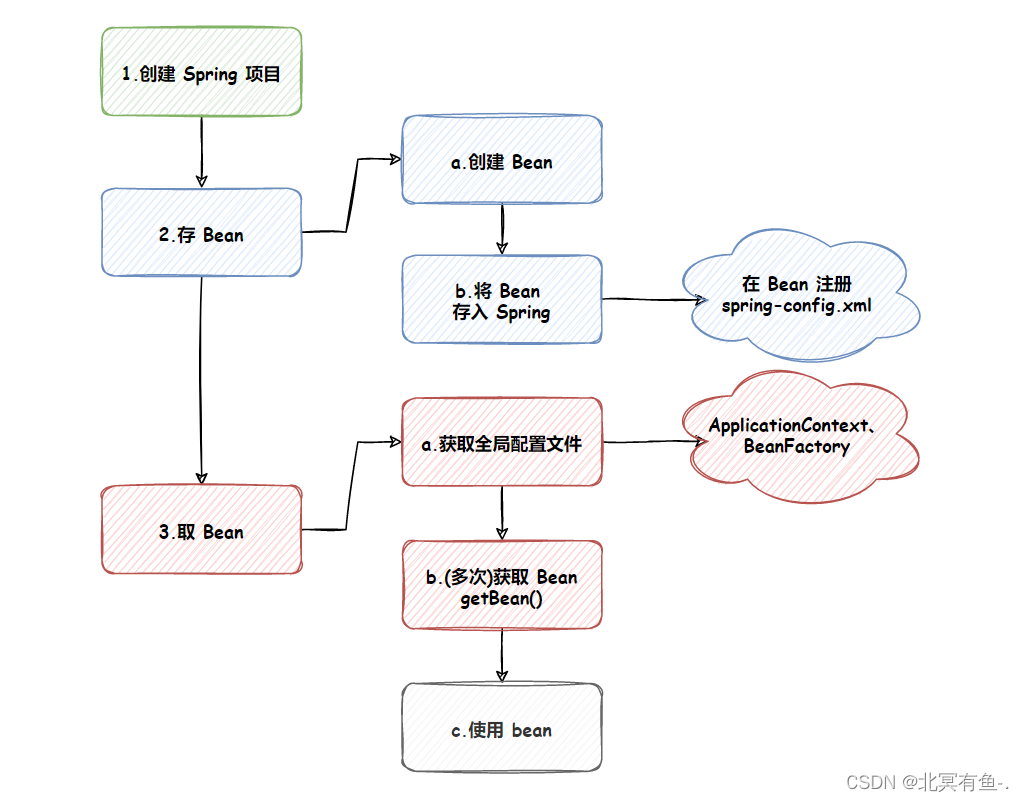
原文地址:https://blog.csdn.net/qq_43339789/article/details/134673846
本文来自互联网用户投稿,该文观点仅代表作者本人,不代表本站立场。本站仅提供信息存储空间服务,不拥有所有权,不承担相关法律责任。
如若转载,请注明出处:http://www.7code.cn/show_45770.html
如若内容造成侵权/违法违规/事实不符,请联系代码007邮箱:suwngjj01@126.com进行投诉反馈,一经查实,立即删除!

